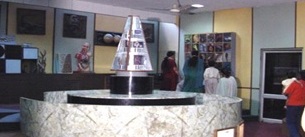Visit to The National Museum of Natural History, class 8
The National Museum of Natural History was established as a national institution during the Silver Jubilee celebrations of India's Independence. To portray and promote awareness about the natural heritage of our country.
An institution devoted to environmental education, with theme-based exhibition galleries, experiential resource centres such as the Discovery Room, Activity Room, and and out-reach activities, it's objective is to depict the country's rich natural heritage and natural history ( geology, botany and zoology). Naturally it was an appropriate place for an educational trip for the students of class 8.
Approximately 100 students and 6 teachers visited the NMNH on 27 December, 2013.
The objectives of the visit to The National Museum of Natural History were :
To expose the students to environmental education,
To view educational projects related to their curriculum and relate it with real life
To gain a hands-on experience of simple activities at the click of a button and
To sensitize the students about the crying need for the conservation of natural resources.
The NMNH has three exhibit galleries, namely: "Introduction of Natural History", "Nature's Network: Ecology" and "Conservation".
Gallery 1: The Gallery of Introduction to Natural History portrays the origin and evolution of life and presents the variety and diversity of the flora and fauna of our country.
Gallery 2: Nature's Network: Ecology presents an overview of the major ecosystems of the world, the role of plants as primary producers, food chains, food webs, decomposition, bio-geochemical cycles, the inter- relationship among plants, animals and human beings, present- day environmental problems such as pollution, deforestation, depletion of wildlife etc. and the reasons ( ethical, aesthetic, economic and scientific) for conservation.
Gallery 3: Conservation deals with many aspects of the conservation of nature. A dramatic life- size diorama of a typical deciduous forest presents two contrasting views (one with a rich, balanced forest ecosystem and the other of denuded, deforested and barren terrain). That, deforestation is the thoughtless exploitation of trees by human beings is presented symbolically through an oversized model of the human hand ruthlessly uprooting a tree. Subsequent sections of the Gallery deals with the depletion of wildlife, endangered species as well as conservation projects. Two exhibits that stand out are on the Bishnoi community and the Chipko Movement.
Discovery and Activity Rooms: Here, the principle of discovery-learning is generally used and learning is through enjoyable activities. Children are sensitised to explore nature, motivated to bring out creative talent and introduced to a sense of enquiry and scientific outlook. There are games, touch- exhibits, and a number of participatory exhibits.
Temporary Exhibitions: Temporary exhibitions on relevant themes are organised by the Museum from time to time, mostly on the 4th floor. Currently an Exhibition on Intangible Natural Heritage is on show.
These sections not only provided useful information to the students and teachers but also served as valuable resources in supplementing our classroom teaching. Undoubtedly, the visit to the museum was both educational and entertaining.
- Report by Ms. Sandhya Batheja.













